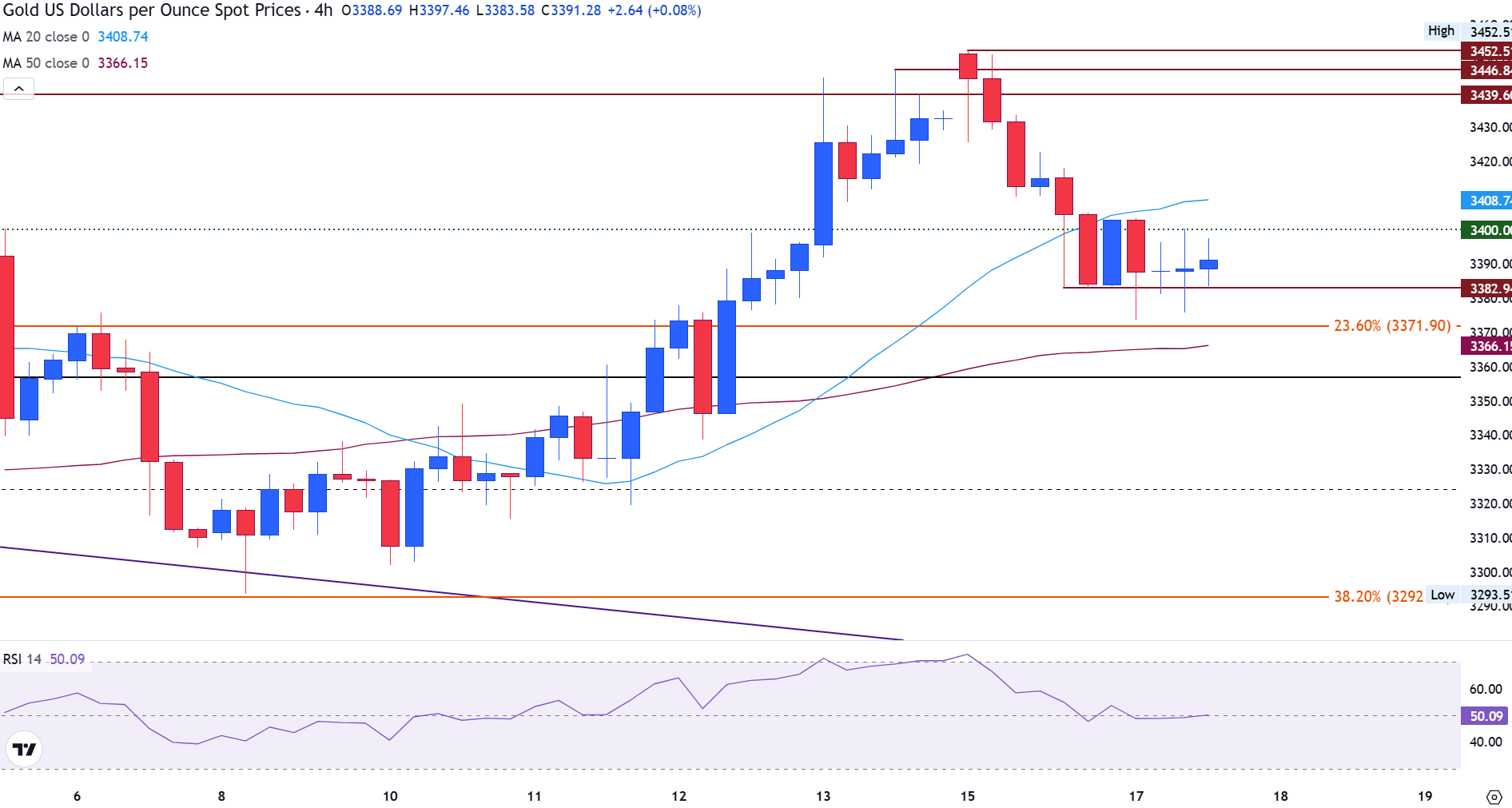- Gold moves toward $3,400 ahead of Wednesday’s Fed interest rate decision.
- Israel-Iran hostilities intensify, supporting Bullion’s safe-haven appeal.
- XAU/USD edges higher as the US Dollar remains under pressure.
Gold moves higher against the US Dollar (USD) on Tuesday as traders digest mixed US Retail Sales data and monitor escalating tensions in the Middle East. At the time of writing, XAU/USD is trading around $3,392, supported by rising safe-haven demand amid renewed geopolitical risks.
The latest US Retail Sales report delivered mixed signals. Headline sales fell 0.9% in May, a steeper drop than the expected 0.7% decline and the sharpest contraction since early 2024.
Sales excluding autos also declined 0.3%, indicating broad-based consumer weakness.
However, the control group, which directly influences Gross Domestic Product (GDP), rose 0.4%, rebounding from April’s -0.1%, suggesting that underlying consumption remains firm.
For the Federal Reserve (Fed), the data complicates the policy outlook. While weaker headline figures strengthen the case for future rate cuts, the firm control group reflects resilience, potentially delaying any monetary easing.
Meanwhile, geopolitical risks continue to support gold prices. The Israel-Iran conflict has intensified, with reports of fresh missile and drone strikes escalating fears of a broader regional war. Concerns over the security of the Strait of Hormuz—a key global oil transit route are further fueling demand for safe-haven assets, such as Gold, as traders brace for potential market disruptions.
Daily digest market movers: Factors to watch for Gold
- The Israel–Iran conflict remains a key upside risk to global inflation, particularly through its potential impact on Oil supply and shipping routes. A sharp escalation could drive energy prices higher, stall progress in disinflation, and force central banks to keep interest rates elevated for longer. This scenario could harm Gold, as it faces competing forces of inflation hedging and higher US yields.
- The US President Donald Trump stated in a post on Truth Social on Tuesday: “I have not reached out to Iran for ‘Peace Talks’ in any way, shape, or form. This is just more HIGHLY FABRICATED, FAKE NEWS! If they want to talk, they know how to reach me.” He added that Iran “should have taken the deal that was on the table — would have saved a lot of lives.”
- Markets reacted after Trump had earlier called for Iranian citizens to evacuate Tehran, warning of further strikes. Israeli Prime Minister Benjamin Netanyahu echoed the message as Israeli airstrikes continued targeting Iranian nuclear and military sites. On Tuesday, Iran’s Revolutionary Guards confirmed new missile and drone attacks on Israeli positions. The growing risk of a full-blown regional war has sent XAU/USD climbing back toward $3,400.
- The focus on Wednesday will be on the Fed’s Summary of Economic Projections (SEP) and the dot plot, which could reveal whether officials still anticipate one or two rate cuts in 2025 or scale back expectations in light of recent inflation risks.
Technical analysis: Gold bulls push back toward $3,400
On the 4-hour chart, Gold (XAU/USD) is consolidating above the $3,375–$3,380 support zone, with prices last seen around $3,392.
The 20-period Simple Moving Average (SMA) at $3,408 is capping immediate upside, while the 23.6% Fibonacci retracement of the recent rally offers support at $3,371. Below that, the 50-period SMA at $3,365 reinforces key demand.
A break above $3,408 could lead to a retest of the monthly highs at $3,446 and $3,452. On the downside, failing to hold $3,371 could expose a deeper retracement toward $3,292, the 38.2% Fibonacci level. The Relative Strength Index (RSI) hovers near 50, indicating neutral momentum with room to extend in either direction.
Gold 4-hour chart

Fed FAQs
Monetary policy in the US is shaped by the Federal Reserve (Fed). The Fed has two mandates: to achieve price stability and foster full employment. Its primary tool to achieve these goals is by adjusting interest rates.
When prices are rising too quickly and inflation is above the Fed’s 2% target, it raises interest rates, increasing borrowing costs throughout the economy. This results in a stronger US Dollar (USD) as it makes the US a more attractive place for international investors to park their money.
When inflation falls below 2% or the Unemployment Rate is too high, the Fed may lower interest rates to encourage borrowing, which weighs on the Greenback.
The Federal Reserve (Fed) holds eight policy meetings a year, where the Federal Open Market Committee (FOMC) assesses economic conditions and makes monetary policy decisions.
The FOMC is attended by twelve Fed officials – the seven members of the Board of Governors, the president of the Federal Reserve Bank of New York, and four of the remaining eleven regional Reserve Bank presidents, who serve one-year terms on a rotating basis.
In extreme situations, the Federal Reserve may resort to a policy named Quantitative Easing (QE). QE is the process by which the Fed substantially increases the flow of credit in a stuck financial system.
It is a non-standard policy measure used during crises or when inflation is extremely low. It was the Fed’s weapon of choice during the Great Financial Crisis in 2008. It involves the Fed printing more Dollars and using them to buy high grade bonds from financial institutions. QE usually weakens the US Dollar.
Quantitative tightening (QT) is the reverse process of QE, whereby the Federal Reserve stops buying bonds from financial institutions and does not reinvest the principal from the bonds it holds maturing, to purchase new bonds. It is usually positive for the value of the US Dollar.

